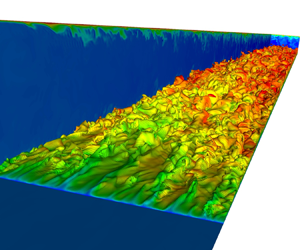No CrossRef data available.
Published online by Cambridge University Press: 11 January 2022

The direct numerical simulation of a non-equilibrium turbulent heat transfer case is performed in a channel flow, where non-equilibrium is induced by a step change in surface temperature. The domain is thus made of two parts in the streamwise direction. Upstream, the flow is turbulent, homogeneous in temperature and the channel walls are adiabatic. The inflow conditions are extracted from a recycling plane located further downstream, so that a fully developed turbulent adiabatic flow reaches the second part. In the domain located downstream, isothermal boundary conditions are prescribed at the walls. The boundary layer, initially at equilibrium, is perturbed by the abrupt change of boundary conditions, and a non-equilibrium transient phase is observed until, further downstream, the flow reaches a new equilibrium state, presenting a fully developed thermal boundary layer. The work aims at identifying the non-equilibrium effects that are expected to be encountered in comparable flows, while providing the means to understand them. In particular, the study allows for the identification of an inner region of the developing boundary layer where several quantities are at equilibrium. Other quantities, instead, exhibit a behaviour of their own, especially in proximity to the leading edge. The analysis is supported by mean and root-mean-square profiles of temperature and velocity, as well as by budgets of first- and second-order moment balance equations for the enthalpy and momentum turbulent fields.